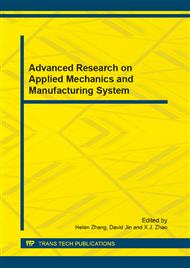p.354
p.360
p.364
p.368
p.372
p.381
p.388
p.394
p.398
Research on Relevance Modeling Method for Equipment Testability in Manufaturing Process
Abstract:
The task of equipment testability design should be carried out during manufacturing process, to improve the diagnostic capabilities of equipment. According to the equipment testing requirements, equipment failure modes and effects analysis were completed, all possible failure modes of the equipment design and manufacturing process were ensured, as well as the causes and impact of each failure mode, whereby the equipment functions and structure were divided. Then, the relevance model was used for testability analysis and modeling of equipment in manufaturing process, relevance graphical model and mathematics model of component units related to equipment were builded, and the preferred method was used to consider the reliability and cost, the equipment diagnostic tree was builded, the equipment testing program was presented. A numerical example indicates that the study can effectively improve the efficiency of the equipment testing and enhance the economy of the test in manufaturing process.
Info:
Periodical:
Pages:
372-380
Citation:
Online since:
December 2012
Keywords:
Price:
Сopyright:
© 2013 Trans Tech Publications Ltd. All Rights Reserved
Share:
Citation:


